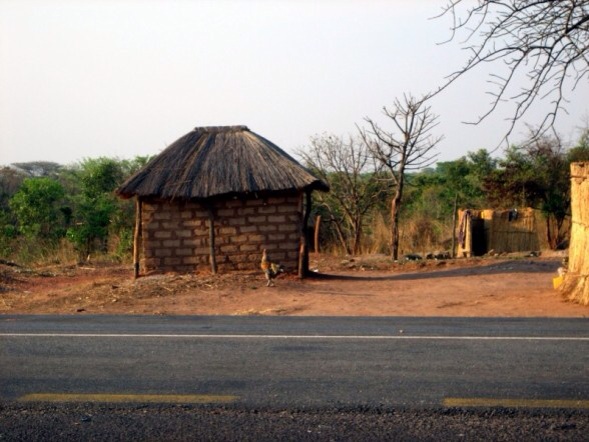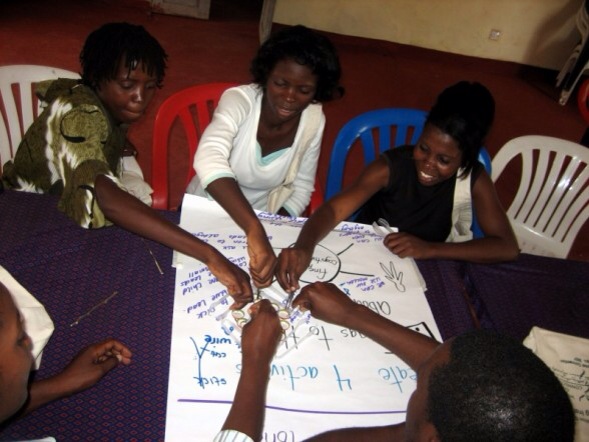Micro-Lending Circles: From Mongu to St. Louis
a presentation to Women’s Voices of St. Louis
March 13, 2014

Mongu
In the weeks leading up to my trip to Zambia with Women’s Global Connection, I was excited about my upcoming trip to do workshops on micro-lending and fundraising in Mongu. And then the day of departure actually arrived and I realized that I had no idea what I was doing. While development workshops were something I could do in my sleep, what I knew of micro-lending was strictly out of a book. With fifty pounds of navy blue uniform shorts in my suitcase, a backpack of protein bars and cheese crackers, and a small carry-on, I took the 18 hour flight to Lusaka.
The next day we departed on an eight hour bus ride through the baking bushlands on roads that looked like rolled cookie dough with ragged edges overtaking the dry beige dust. Waves of dry heat distorted the sparse trees in the distance.
The OK Restaurant greeted us upon our arrival in Mongu. Entrepreneurs were everywhere–setting up shop in little corrugated buildings of ultramarine, orange, scarlet and grass green selling wood block stamped fabrics, bottled drinks, hard boiled eggs on sticks.
I was prepared, powerpoint presentation in hand, to present a workshop the next day to a group of Lotsi tribeswomen so that they could begin their micro-lending circle. The women arrived in brightly batiked dresses. One woman had lost her home to a fire in the past week. Many had seen family members die from AIDS. All lived with limited means. Despite this, the women were happy and optimistic. They had recently formed a rice collaborative to capitalize on the high demand for the famed iron-rich rice of the western province and had been given land to farm by the tribe. That was a big step.
We sat to begin our circle. They spoke Lotsi–I spoke English. The handouts made great scrap paper. Sennana, an Oxford-educated princess of the Lotsi tribe, served as an able translator and I discarded my presentation and started with questions:
Why did they want to create a micro-lending circle?
What could the funds be used for and what projects were outside the circle?
Who could participate?
What was the amount for a loan?
How long could you take to pay it back, and what was the interest?
The women had their own circle process. For each question they would start at a different point in the circle. The reason for micro-lending was simple. They wanted to start businesses–that should have been obvious to me given that the entire town was given over to small entrepreneurs. Funds could be used for micro-enterprises, for their children’s education fees, for funerals, but not for bottle–liquor–stores.
They quickly settled on loan terms and interest rates. Actually they were so efficient that they completed the micro-lending design in the morning and took the afternoon to develop a business plan for their rice business.
And then they danced.
St. Louis
When I returned to St. Louis I was determined to bring the micro-lending concept here. The Incarnate Word Foundation provided $5,000 in seed money to each bank. Women came together at Midtown Catholic Community Services, Haven of Grace, Let’s Start and East Side Heart and Home to begin their own circles.
There were no rules. Each group developed their own lending policies, repayment plans and interest rates. Most of the banks have interest rates that hover at about 5%. Usually loans are for no more than $500 and can be used not only to start a micro-business, but also to buy an appliance, provide a down payment on an apartment, or repair a car.
A partnership with the St. Louis Chapter of the National Council of Jewish Women (NCJW) took the micro-lending circles to a new level. After an initial grant form the Incarnate Word Foundation the NCJW took the micro-lending circles to a new level by providing a mentoring component and focusing on women had suffered from domestic violence or limited economic opportunity. In two years they have expanded to five Helping Heart Banks serving women connected to Lydia’s House, Safe Connections, ROW, and the YWCA. Their efforts have also expanded to credit repair as they link women who are paying their loans back with the Credit Builder’s Network so that the women are able to repair their credit scores.
Banks like the Women’s Helping Hands Bank continue to make loans based on a “face check” not a credit check. That particular group has gone on to develop a cooperative farmers market, City Greens, as well as a matched saving program for neighborhood youth. The bankers of Women’s Helping Hands Bank have not only developed a handbook on micro-lending but also presented at Ecumenical Advocacy Days in Washington. That trip was a highlight not only for them, but also for me as I sat and listened to them tell other leaders how they had started a micro-lending circle that had blossomed into other enterprises.

What does it all mean?
For me the most important outcomes from micro-lending aren’t repayment rates or bank assets. What really matters is empowerment.
Each bank begins with the women themselves. They set the agenda. Their opinions are the ones that matter. After years and sometimes decades of being told what to do they are now the decision-makers. In one instance the women began by saying that they couldn’t do it–they didn’t feel they had the education or ability. But inspired by the example of the Lotsi women, they went ahead and did it anyway. No one stepped in to do it for them; instead other women walked with them to reassure, encourage and celebrate.
The affirmation that the women bankers and clients experience is the heart of each bank.
What does it feel like to finally be able to make decisions?
When does apprehension evolve into trust?
How does empowerment change our relationships with our children?
How does empowerment change how we see ourselves and the world?
I went to Mongu to teach women about micro-lending and the women of Mongu and St. Louis ended up teaching me.


